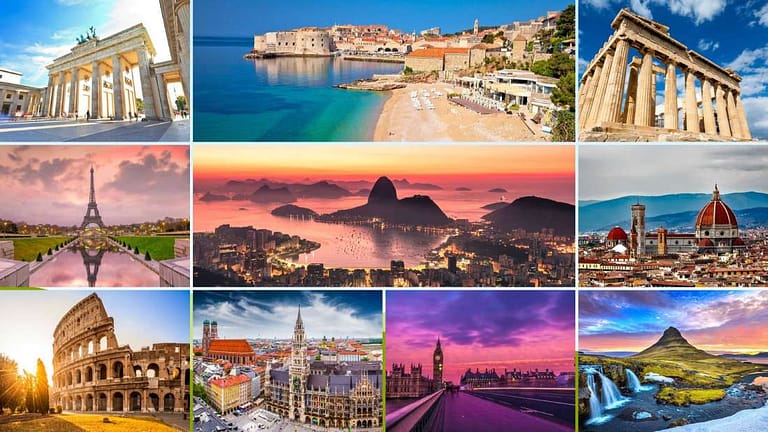Lost in Time: Visiting Countries That No Longer Exist
There is a cultural aspect to travel that sometimes you don’t fully understand until you go somewhere. Travelling to countries that no longer exist, for example, can be a fascinating and enlightening experience. Local cultures and traditions sometimes tend to blur the political boundaries, and what you get is a tapestry of tales that books don’t teach you about.
When most people think of countries that no longer exist, they probably imagine the lost tribes and civilizations of centuries gone by. While that is a reasonable assumption, we don’t have to look very far back in time to find them. Many countries rose to power and then ceased to exist during the 20th century. Others existed a lot longer yet met the same fate.
Affiliate Disclosure – This post contains affiliate links. If you make a purchase through these links, I may earn a commission. This doesn’t affect your purchases or any fees you may pay for the product or service. Read more in my DISCLAIMER.
Political conflicts and wars often change boundaries. Such events trigger the ascent and fall of countries and whole empires. The 20th century saw a lot of turmoil that forever changed boundaries in Europe and many other places worldwide.
Countries that no longer exist thanks to changes in the 20th century
Some countries on this list might be familiar, while others are straight out of history books. Travellers back in the 1960s and 1970s would have had an opportunity to visit some of these countries. On the other hand, those born in the 1990s now have a chance to travel to countries that didn’t exist before they were born. This means that grandparents and their grandchildren could have visited the same place but in different countries. How is that for multigenerational travel chat?
Austria-Hungary (1867-1918)

Austria-Hungary was a significant player in the European scene, lasting from 1867 to 1918. While relatively short in existence, the Austro-Hungarian empire played an essential role in starting a major war. As the story goes, the assassination of Franz Ferdinand, the heir to the Austro-Hungarian throne, by a Bosnian Serb national triggered the outbreak of World War I.
As the empire ended up on the losing side of the battle, it was split up at the end of the war into the countries we know today as Austria and Hungary. However, the empire also included parts of the Czech Republic, Poland, Italy, Romania and the Balkans.
Ceylon (1505-1972)
Going back to 1505, Ceylon has a pretty interesting history as a trading hub with Arab and European influences. Ruled by the Portuguese, the Dutch, and the British, it finally gained full independence in 1948.
In 1972, Ceylon changed its name to become what we know today as Sri Lanka. This might explain why Sri Lanka seems to be a relatively unknown country to many. As tourism expands, more people will learn more about this relatively young nation and its centuries-old history.

Czechoslovakia (1918-1993)
Created after the fall of the Austro-Hungarian empire, Czechoslovakia was clumped together using Czech and Slovak lands. It was a relatively prosperous country that came under German occupation during WWII and then under Soviet power, much like the rest of Eastern Europe.
In 1993, Czechs and Slovaks split peacefully into individual countries, each with its own history and culture. So today, you can add two new countries to your list that didn’t exist a generation ago. Read more about visiting Prague.
East and West Germany (1945-1990)
In the not-so-distant past, there were two Germanies. East and West. After the fall of the Nazis at the end of World War II, Germany was split into zones between the Allied nations. The zones under British, French and U.S. control formed West Germany while East Germany was under Soviet rule. Tensions grew, splitting families into two countries as the Cold War entered the stage.
While Western Germany prospered, the people in Eastern Germany didn’t fare so well. The decades took their toll as they did in the rest of Europe. Changing political climate, failing economy and the winds of change finally led to the famous fall of the Berlin Wall and Germany’s subsequent reunification.

Neutral Moresnet (1816 to 1920)
If you’ve never heard of Neutral Moresnet before, don’t worry, you’re not alone. This small parcel of land, smaller than New York’s Central Park, remained its own governing body for over a century.
Separating the United Kingdom of the Netherlands and Prussia, Neutral Moresnet had a zinc mine that made it very valuable. After the zinc ran out and other attempts at prosperity failed, Neutral Moresnet became part of Belgium after WWI.
Newfoundland (1907-1949)
Newfoundland was the last province to join modern-day Canada. Before that, like the rest of the country, it too, became a British colony. However, it briefly became a self-governing independent nation in 1907. Economic challenges of the Great Depression played a role in Newfoundland, eventually joining Canada in 1949.
Today, Newfoundland is a fascinating place to visit. Stunning landscapes, rich culture and friendly people are just some of the reasons you should go there if you’re visiting Canada. You’ll discover a totally unexpected place to love.

Ottoman Empire (1299-1922)
Much like other grand empires, the end of the Ottoman Empire was inevitable. Like the Roman and Byzantine Empires preceding it, the Ottoman Empire ruled for centuries and covered vast parts of the world, crossing continents. Once stretching as far north as Hungary, Russia and the Balkans, down to the Persian Gulf with parts of the Middle East and North Africa, the Ottoman Empire ended in 1922.
While the empire’s decline didn’t happen overnight, gradually, its power deteriorated. If the Ottoman Empire hasn’t sided with the losing side in WWI, its demise might have occurred later. As with other countries on this list, the war’s end meant that the Ottoman Empire was split up and eventually abolished once the Turks won their independence in 1922.

Prussia (1525-1947)
Prussia became a Dutchy in 1525 before becoming a kingdom. Ruled by the House of Hohenzollern, Prussia extended over large parts of modern-day Germany and Poland as well as parts of Lithuania, Belgium, Denmark, France, the Czech Republic and Switzerland.
Prussia enjoyed great military success during the 18th century under the rule of Frederick II. Fighting in many European wars, Prussia eventually suffered defeat under Napoleon in the early 1800s. This weakened the kingdom and its territories.
With its capital in Berlin, Prussia became a part of the newly unified Germany during the 19th century. While the end of WWI ended the Prussian monarchy, the end of WWII marked its abolishment. Today, Prussia is one of those countries that no longer exist, and many have forgotten about it.
Interested in learning more about countries that no longer exist? Check out:
- Stunning Art Nouveau In Riga: Architecture Meets Fantasy
- Discover The Best Of Gdansk Old Town Architecture
- Old City Of Dubrovnik Croatia For The History Lover In You
Sikkim (1642 to 1975)
I must say that I have a very vague recollection of Sikkim from my class on Indian history, but most people have probably never heard of it. The monarchs of Sikkim ruled independently from the 17th century until Sikkim joined India in 1975. That doesn’t seem like that long ago.
Sikkim was once one of the largest monarchies with strong political power. The monarchy had a colourful and tumultuous history over the centuries, including ties to the British Empire. While there were many conflicts in its history, the merging with India after a referendum was a peaceful affair.
Soviet Union (USSR) (1922-1991)
If you were born in the 1990s, you probably aren’t as familiar with the Soviet Union as those born in previous generations. Unless you watch a lot of movies. The Soviet Union lasted from 1922 to 1991, and its collapse brought us 15 new countries. The fall of the Soviet Union also marked the collapse of Communism, ending its iron grip on Eastern Europe. Enter new ideas, modernization and opening up to the world. Hello, 15 new countries.

These new countries became Armenia, Azerbaijan, Belarus, Estonia, Georgia, Kazakhstan, Kyrgyzstan, Latvia, Lithuania, Moldovia, Russia, Tajikistan, Turkmenistan, Ukraine and Uzbekistan. As the Soviet Union ruled for decades and travel was restricted within its boundaries, most people born in that time had very little (if any) knowledge of these countries and their histories.
Tibet (1912-1951)
Tibet’s history goes back over a thousand years; however, it wasn’t until 1912 that it became an independent country. Tibet managed to stay independent under the Dalai Lamas until the Chinese occupation ended its independence in 1951.
United Arab Republic (1958-1971)
One of the less talked about countries that no longer exist is the United Arab Republic. The UAR was a short-lived dream of then-Egyptian President Gamal Abdel Nasser. Egypt and Syria’s union meant to unite the two countries into a pan-Arab state based on nationalism and solidarity. Physical separation and conflicting views ended the union with Syria’s departure just three years later. Egypt retained the moniker until Nasser died in 1971.

Yugoslavia (1918-1992)
Yugoslavia was like Frankenstein’s monster, patched together with different and ill-fitting pieces of other cultures. Much like Czechoslovakia, Yugoslavia was formed after the fall of the Austro-Hungarian Empire at the end of WWI. While it also fell under Hitler’s rule during WWII, the country avoided Soviet occupation and marched straight into Communism under the socialist dictatorship of Marshal Josip Tito.
Unlike Czechoslovakia, the cultural, ethnic and religious differences finally took their toll. The breakup of Yugoslavia was a violent affair, with more than 100,000 dead during the conflict. Out of that came new countries we know as Bosnia and Herzegovina, Croatia, Serbia, Slovenia, Macedonia and Montenegro, including the independent region of Kosovo.

Bonus: the British Empire (1497-1997)
The British Empire, once referred to as the empire “where the sun never sets,” was at its height, the largest ever to exist. It is said that the British have invaded nine out of 10 countries in the world during its domination. That’s a pretty impressive run for a relatively small island nation that ended up invading all but 22 nations.

Some date the start of the empire around 1497 when the first British surveyors reached the New World on behalf of the crown. Others date it back to the early 1600s. Either way, it’s still a very long time. The height of the British Empire was around 1921. It then gradually started to decline as the 20th century went on. The official handover of Hong Kong to China marked the official end of the British Empire.
I decided to include this as part of the countries that no longer exist, even though this is an empire. With the fall of the British Empire, many nations regained their independence. As pieces of the empire chipped away, the geographical boundaries and political alliances shaped new countries while rediscovering others. For that reason, the British Empire deserves a spot on this list.
Additional countries that no longer exist or have new names
To try and identify all countries that no longer exist, have different names or have been merged with others is an arduous task. I want to tackle that project one day as I think it’s a fascinating concept.
As I’ve focused on the last 100 years, a few other countries that no longer exist and are worth noting here. This list of countries that no longer exist will give you an idea of how complicated the histories of these places are, and I hope you explore them further. I know I definitely will be doing more research.
- Abyssinia became Ethiopia
- Basutoland is now known as Lesotho
- Bengal became part of India and Bangladesh
- Burma is now known as Myanmar
- East Pakistan became Bangladesh
- Gran Colombia once included Panama, Colombia, Ecuador and Venezuela
- New Grenada is now known as the Republic of Colombia
- North Yemen and South Yemen united in 1990 as Yemen
- Rhodesia became Zimbabwe
- Siam is now known as Thailand
- Southwest Africa became Namibia
- Tanganyika united with Zanzibar to form Tanzania
- Zaire is now known as the Democratic Republic of the Congo
- Zanzibar united with Tanganyika to form Tanzania
Does visiting countries that no longer exist impact your travel experience?
While visiting countries that no longer exist may not mean much to some, it is essential to others. It’s not always about what the country is called but more about its history and culture. Wars and conflicts often result in new boundaries, which aren’t always created to everyone’s liking.
Even today, many culturally distinct nations across the world are part of a larger country (like Scotland and Wales). Many still fight for independence (like Tibet and Catalonia), while others enjoy an autonomous status (like Greenland and Curacao). Travel allows us to learn first-hand about the people we meet and their cultures. Things aren’t always taught in school but make up a considerable part of the local identity.
So, while visiting a country can be an experience of its own, learning more about its history can further enrich that experience. That is why I travel and love learning about the places I visit. How the maps will change in the future is anyone’s guess. We might see some countries disappear and others emerge on the stage.
FAQ
Travel Resources
Planning your next trip? Check out the resources I use and start planning your perfect getaway today!
- Flights: Find the best flight deals on Kiwi.com (my new go-to for flights)
- Book your accommodations: Find the best prices on hotels with Booking.com
- What to do: Find the perfect tour with Viator
- Need a car? Book your ride with Rentalcars.com
Check out my travel resource guide for more resources to help you plan your trip.








